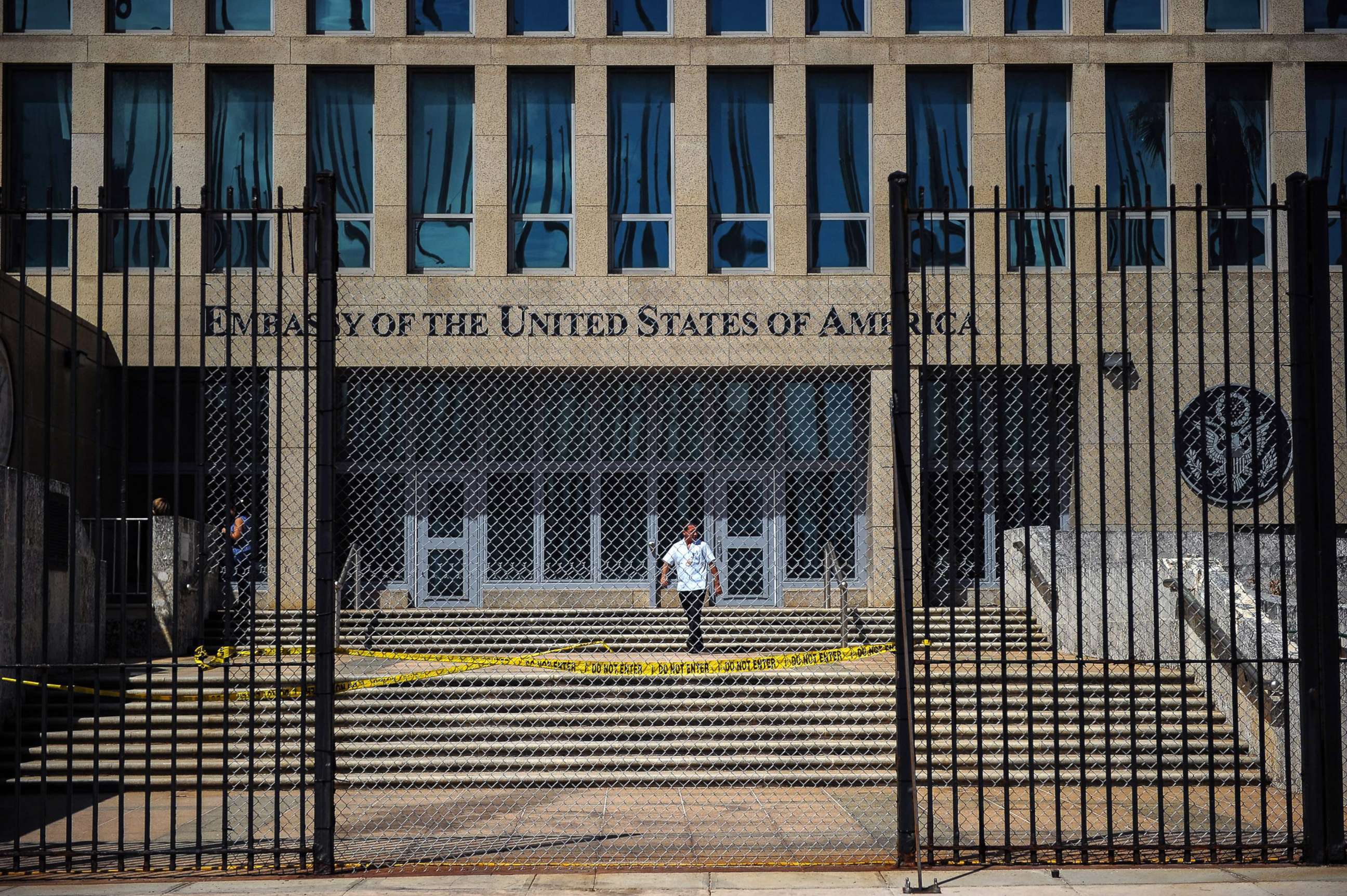'Havana syndrome' could be caused by external energy source: Intel community experts
The findings again leave open the possibility an actor is responsible for cases.
The U.S. intelligence community still has not determined what is causing the debilitating symptoms and bizarre experiences of hundreds of U.S. government personnel in dozens of locations around the world, according to a new report by a panel of experts.
But the latest intelligence report on what's commonly called "Havana syndrome" -- because the first cases were reported at the U.S. embassy in Cuba -- does narrow the scope and suggest that "pulsed electromagnetic energy, particularly in the radio frequency range," could be responsible. That leaves open the possibility that an actor or device is responsible, just as a CIA assessment last month did for a smaller group of affected personnel.
The panel of experts -- drawn from science, medicine, and engineering and in and out of the U.S. government -- ruled out several causes for a key group of affected personnel whose cases continue to baffle U.S. officials and medical professionals, including radiation, chemical or biological agents, and sound waves from a "large" distance.
The report, however, found that ultrasound at a close range could also be responsible, while psychogenic factors like stress could exacerbate individual cases or cause other reported incidents.
But the signs and symptoms of AHIs, or anomalous health incidents as the Biden administration calls them, are "genuine and compelling," according to an intelligence official familiar with the IC expert panel's work, including damage to nervous system cells and reports of traumatic brain injury. Some critics have previously dismissed reports as false or "mass hysteria."

Wednesday's report is the latest effort by the intelligence community to explain the mysterious set of symptoms reported by U.S. diplomats, spies, and other personnel in Cuba and beyond, including major clusters last year in Vienna, Austria, and Bogotá, Colombia.
"The work of the IC Experts Panel will help sharpen the work of the IC and broader U.S. Government as we focus on possible causes. We will stay at it, with continued rigor, for however long it takes," Director of National Intelligence Avril Haines and CIA Director Bill Burns said in a joint statement after the report's executive summary was publicly released.
Last month, the CIA issued an assessment that the "majority" of reported incidents can be "reasonably explained by medical conditions or environmental and technical factors," a senior CIA official told ABC News at the time. But they left the door open to the possibility that some personnel have been attacked by a still-unknown actor or device, saying a foreign actor's role has not been ruled out "in specific cases. We're still looking."
That smaller group of affected personnel's cases "cannot be easily explained by known environmental or medical conditions and could be due to an external stimuli," according to Wednesday's new report, which largely focused on those cases.
It's unclear still what that could be, including whether it is a device or weapon of some kind -- a theory that has been floated in the five years since the first cases were reported in Havana.
"It's more than theory," the intelligence official said Wednesday. "A very specific device with parameters that would result in the biological effects -- we don't have one of those."
But the panel reviewed the firsthand experience of researchers in a lab setting who experienced radio frequency and ultrasound and reported symptoms and experiences similar to four characteristics that define the smaller group of unexplained cases.

While officials declined to say how many cases this group includes, they said those characteristics are a common set of experiences: "The acute onset of audio vestibular sensory phenomenon; vertigo, loss of balance, and ear pain; a strong sense of locality or directionality; and the absence of known environmental or medical conditions that could have caused the reported signs and symptoms."
"Whether or not it's directed energy, we don't have enough information to know. But it seems that there are a small number of the cases we looked at that had no other plausible mechanism that we currently knew, so we left it open for the possibility of other mechanisms, such as directed energy," said a second intelligence official familiar with the findings.
In particular, the report found that pulsed electromagnetic energy can disrupt cells and tissues, is possible to create in a "concealable" way with "moderate" power, and can be transmitted up to hundreds of meters through the air or a shorter ranges through buildings, the officials said.
But the first intelligence official said there are still "information gaps" in the theory, especially because of a "dearth of systematic research on the effects of the relevant electromagnetic signals on humans." Sections of the expert panel's executive summary on the energy waves are redacted.
The other mechanism that was not ruled out by the expert panel was ultrasound, which "also plausibly explains the core characteristics, but only in close-access scenarios and with information gaps," according to the first intelligence official.
Ultrasound waves can produce a tight beam and be portable, but it would need to be close to a victim to affect them, they said.
While incidents of "Havana syndrome" have been repeatedly dismissed in some corners as "mass hysteria," the intelligence report said the psychological phenomenon "cannot alone account for the core characteristics, although they may cause some other incidents or contribute to long-term symptoms," according to the first intelligence official.
In other words, the surge in reported incidents in recent years, spanning every continent except Antarctica, could be in part because of "psychosocial factors," including "hyper vigilance and normal human rights to stress and ambiguity," said the official, especially given spies and diplomats are more "attuned to [their] surroundings and trained to think about security."
For some personnel affected by unexplained incidents, that stress and anxiety could worsen existing symptoms, too, the report said.
That's not to say that personnel impacted by psychosocial factors aren't experiencing real symptoms either, with stress and mass psychogenic illness capable of causing debilitating health effects like neurological disorders.
"No case should be discounted," said the first intelligence official.
But the report did rule out ionizing radiation, chemical and biological agents, infrasound, audible sound, ultrasound propagated over large distances, and bulk heating from electromagnetic energy" as "implausible explanations" for this core group of unexplained cases.
"These mechanisms are unlikely on their own to account for the required effects or are technically or practically infeasible," said the first official.
The lack of a definitive answer continues to confound officials in the intelligence community and across the U.S. government.
"It's frustrating, but we're just as persistent to help understand and elucidate what's happening," the first official said. "The cases are not consistent, they're heterogeneous -- that adds a dimension that is challenging to this."
The report calls on the U.S. government to better collect data on reported incidents and affected personnel, match incident and patient data, and boost its capacity to investigate incidents as soon as they're reported.
That includes through "detectors," officials said, declining to provide more information. In the executive summary, the section on detectors, along with "devices to aid research," are redacted.
In November, Secretary of State Antony Blinken said the U.S. was "developing, obtaining, and deploying technology to the field to protect our personnel" and "more quickly and thoroughly evaluate a variety of potential causes." He declined to say more about sensitive technology.
The expert panel had dozens of briefings, reviewed more than 1,000 pages of classified information, and interviewed between 10 and 20 affected U.S. personnel -- including reviewing medical records for them and "many, many more" affected employees.
"This is the first time a panel has had such wide-ranging access to intelligence reporting and patient data and has engaged directly with affected individual," Dr. Eric Lander, President Biden's science advisor and director of the White House Office of Science and Technology Policy, said in a statement.
Their findings echo a December 2020 report by the National Academies of Sciences, Engineering, and Medicine that concluded, "Directed, pulsed radio frequency energy appears to be the most plausible mechanism." A "small number" of the intelligence community panel's members were also a part of the team that produced that report.




